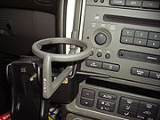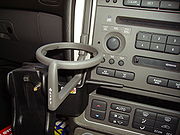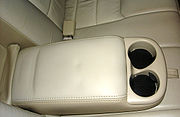
Cup holder
Encyclopedia
A cup holder is a device to hold a cup or other drinking vessel. It is a fixture in automobile
s, train
s, and other vehicles, as well as in some movie theatres, sports arena
s, etc.

 The development of the drive-in restaurant was a step in the cupholder's development. Servers would attach a tray that hooked over the car's side window, which needed to be left up a little for it to attach to. This gave a temporary table to hold drinks and food while eating in the car. The drive-in restaurant and cinema
The development of the drive-in restaurant was a step in the cupholder's development. Servers would attach a tray that hooked over the car's side window, which needed to be left up a little for it to attach to. This gave a temporary table to hold drinks and food while eating in the car. The drive-in restaurant and cinema
encouraged the development of built-in tray tables; often, the inside of the glove compartment
lid, when folded down, had indentations to hold cups and cans, and were found in cars as early as the 1957 Chevrolet Bel Air
. These were sufficient to hold beverages when the car was stopped, but not while in motion.
The later development of the drive-through
restaurant encouraged the development of better holders for drinks, and a more fast-paced life and longer commute times made many drivers desire to drink their morning coffee in the car on the way to work. The 1960s saw coffee cups with wide, flat, rubberised bases being sold, which would keep them steady on the dash or console. A little later, aftermarket cupholders began to be sold. These often clipped onto the door windows, although other designs wedge in between the front seats and the center console.
Built-in cupholders began to be available in the 1980s. Minivan
s were pioneers in their availability, and they still offer the greatest number of them. Over time, automotive cupholders have become larger and more sophisticated, so that they can hold a variety of different cup sizes securely. Many offer spring-loaded holders that clasp the cup securely, no matter how large or small. The development of ever-larger cups by fast-food chains and convenience store
s in the United States
has proven a challenge to automotive designers; many fast-food chains now offer 44 fl.oz. (1.3 L) drinks. The automobile cup-holder has also driven the development of "car cups" designed to fit within most cars' cup holders; these have a narrower base but flare outward after a short cylindrical distance.
The installation of cup holders in automobiles increased significantly after Stella Liebeck v. McDonald's Corporation, where a 79-year-old woman in Albuquerque, New Mexico
ordered hot coffee
from a McDonald's
restaurant. She then spilled the coffee on her lap and was seriously scalded. She subsequently sued McDonald's in a jury trial
. Liebeck was awarded US$
2.7 million in damages
by the Jury, which was later reduced by the judge to US$640,000. The case was settled privately for an undisclosed sum.
Many people, particularly in the United States, consider the design, location and number of cup holders in a vehicle to be one of the most important attributes influencing their vehicle purchase. Others take the contrary view; that they are irrelevant, and encourage a dangerous practice which distracts drivers
from their primary task. Cars designed primarily for the North American market have tended to have larger cupholders, while those for which the primary market is outside of North America tend to have smaller ones.
In Europe, cupholders in cars are not used as much as in the United States and are viewed with contempt by some motorists. However, as most cars are now built for a global market, including the United States, many cars in Europe do feature cupholders.
 Before the automobile cup holders, many bus
Before the automobile cup holders, many bus
es and train
s were built with wall-mounted cup holders. These cup holders are usually constructed by thin stainless steel
plates. Some of them are covered by rubber
.
Automobile
An automobile, autocar, motor car or car is a wheeled motor vehicle used for transporting passengers, which also carries its own engine or motor...
s, train
Train
A train is a connected series of vehicles for rail transport that move along a track to transport cargo or passengers from one place to another place. The track usually consists of two rails, but might also be a monorail or maglev guideway.Propulsion for the train is provided by a separate...
s, and other vehicles, as well as in some movie theatres, sports arena
Arena
An arena is an enclosed area, often circular or oval-shaped, designed to showcase theater, musical performances, or sporting events. It is composed of a large open space surrounded on most or all sides by tiered seating for spectators. The key feature of an arena is that the event space is the...
s, etc.
Automobiles


Drive-in theater
A drive-in theater is a form of cinema structure consisting of a large outdoor screen, a projection booth, a concession stand and a large parking area for automobiles. Within this enclosed area, customers can view movies from the privacy and comfort of their cars.The screen can be as simple as a...
encouraged the development of built-in tray tables; often, the inside of the glove compartment
Glove compartment
A glove compartment or glovebox, also known as a little cupboard, is a compartment built into the dashboard, located over the front-seat passenger's footwell in an automobile, often used for miscellaneous storage. The name derives from the original purpose of the compartment, to store gloves...
lid, when folded down, had indentations to hold cups and cans, and were found in cars as early as the 1957 Chevrolet Bel Air
Chevrolet Bel Air
The Chevrolet Bel Air is a full-size automobile that was produced by the Chevrolet division of General Motors for the 1950–1975 model years. Hardtops in the Chevrolet Deluxe Styleline model range were designated with the Bel Air name from 1950–1952, but it was not a distinct series of its own until...
. These were sufficient to hold beverages when the car was stopped, but not while in motion.
The later development of the drive-through
Drive-through
A drive-through, or drive-thru, is a type of service provided by a business that allows customers to purchase products without leaving their cars. The format was first pioneered in the United States in the 1930s but has since spread to other countries. The first recorded use of a bank using a drive...
restaurant encouraged the development of better holders for drinks, and a more fast-paced life and longer commute times made many drivers desire to drink their morning coffee in the car on the way to work. The 1960s saw coffee cups with wide, flat, rubberised bases being sold, which would keep them steady on the dash or console. A little later, aftermarket cupholders began to be sold. These often clipped onto the door windows, although other designs wedge in between the front seats and the center console.
Built-in cupholders began to be available in the 1980s. Minivan
Minivan
Minivan is a type of van designed for personal use. Minivans are typically either two-box or one box designs for maximum interior volume – and are taller than a sedan, hatchback, or a station wagon....
s were pioneers in their availability, and they still offer the greatest number of them. Over time, automotive cupholders have become larger and more sophisticated, so that they can hold a variety of different cup sizes securely. Many offer spring-loaded holders that clasp the cup securely, no matter how large or small. The development of ever-larger cups by fast-food chains and convenience store
Convenience store
A convenience store, corner store, corner shop, commonly called a bodega in Spanish-speaking areas of the United States, is a small store or shop in a built up area that stocks a range of everyday items such as groceries, toiletries, alcoholic and soft drinks, and may also offer money order and...
s in the United States
United States
The United States of America is a federal constitutional republic comprising fifty states and a federal district...
has proven a challenge to automotive designers; many fast-food chains now offer 44 fl.oz. (1.3 L) drinks. The automobile cup-holder has also driven the development of "car cups" designed to fit within most cars' cup holders; these have a narrower base but flare outward after a short cylindrical distance.
The installation of cup holders in automobiles increased significantly after Stella Liebeck v. McDonald's Corporation, where a 79-year-old woman in Albuquerque, New Mexico
Albuquerque, New Mexico
Albuquerque is the largest city in the state of New Mexico, United States. It is the county seat of Bernalillo County and is situated in the central part of the state, straddling the Rio Grande. The city population was 545,852 as of the 2010 Census and ranks as the 32nd-largest city in the U.S. As...
ordered hot coffee
Coffee
Coffee is a brewed beverage with a dark,init brooo acidic flavor prepared from the roasted seeds of the coffee plant, colloquially called coffee beans. The beans are found in coffee cherries, which grow on trees cultivated in over 70 countries, primarily in equatorial Latin America, Southeast Asia,...
from a McDonald's
McDonald's
McDonald's Corporation is the world's largest chain of hamburger fast food restaurants, serving around 64 million customers daily in 119 countries. Headquartered in the United States, the company began in 1940 as a barbecue restaurant operated by the eponymous Richard and Maurice McDonald; in 1948...
restaurant. She then spilled the coffee on her lap and was seriously scalded. She subsequently sued McDonald's in a jury trial
Jury trial
A jury trial is a legal proceeding in which a jury either makes a decision or makes findings of fact which are then applied by a judge...
. Liebeck was awarded US$
United States dollar
The United States dollar , also referred to as the American dollar, is the official currency of the United States of America. It is divided into 100 smaller units called cents or pennies....
2.7 million in damages
Damages
In law, damages is an award, typically of money, to be paid to a person as compensation for loss or injury; grammatically, it is a singular noun, not plural.- Compensatory damages :...
by the Jury, which was later reduced by the judge to US$640,000. The case was settled privately for an undisclosed sum.
Many people, particularly in the United States, consider the design, location and number of cup holders in a vehicle to be one of the most important attributes influencing their vehicle purchase. Others take the contrary view; that they are irrelevant, and encourage a dangerous practice which distracts drivers
Driving
Driving is the controlled operation and movement of a land vehicle, such as a car, truck or bus.Although direct operation of a bicycle and a mounted animal are commonly referred to as riding, such operators are legally considered drivers and are required to obey the rules of the road...
from their primary task. Cars designed primarily for the North American market have tended to have larger cupholders, while those for which the primary market is outside of North America tend to have smaller ones.
In Europe, cupholders in cars are not used as much as in the United States and are viewed with contempt by some motorists. However, as most cars are now built for a global market, including the United States, many cars in Europe do feature cupholders.
The bus/train cup holder

Bus
A bus is a road vehicle designed to carry passengers. Buses can have a capacity as high as 300 passengers. The most common type of bus is the single-decker bus, with larger loads carried by double-decker buses and articulated buses, and smaller loads carried by midibuses and minibuses; coaches are...
es and train
Train
A train is a connected series of vehicles for rail transport that move along a track to transport cargo or passengers from one place to another place. The track usually consists of two rails, but might also be a monorail or maglev guideway.Propulsion for the train is provided by a separate...
s were built with wall-mounted cup holders. These cup holders are usually constructed by thin stainless steel
Stainless steel
In metallurgy, stainless steel, also known as inox steel or inox from French "inoxydable", is defined as a steel alloy with a minimum of 10.5 or 11% chromium content by mass....
plates. Some of them are covered by rubber
Rubber
Natural rubber, also called India rubber or caoutchouc, is an elastomer that was originally derived from latex, a milky colloid produced by some plants. The plants would be ‘tapped’, that is, an incision made into the bark of the tree and the sticky, milk colored latex sap collected and refined...
.
External links
- How U.S. car design came to include cup holders. - Henry Petroski, Slate.com, 15 March 2004.
- My cup runneth over - James MayJames MayJames Daniel May is an English television presenter, journalist and writer. He is best known for his role as co-presenter of the award-winning motoring programme Top Gear alongside Jeremy Clarkson and Richard Hammond....
, The Daily Telegraph (UK)The Daily TelegraphThe Daily Telegraph is a daily morning broadsheet newspaper distributed throughout the United Kingdom and internationally. The newspaper was founded by Arthur B...
, 19 June 2004.

